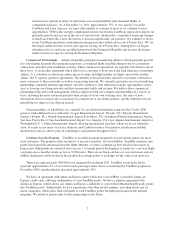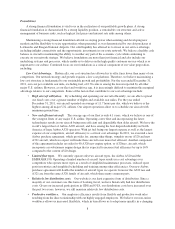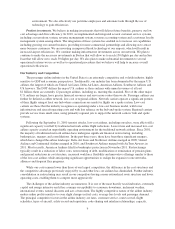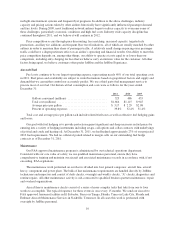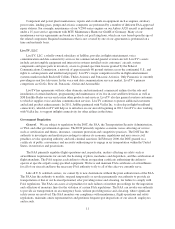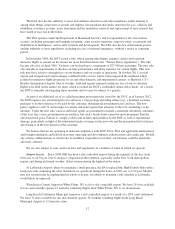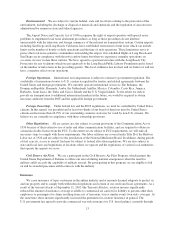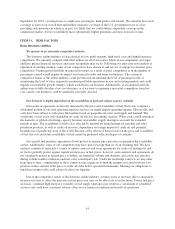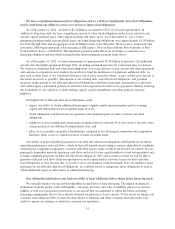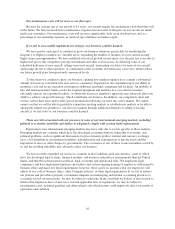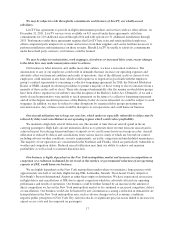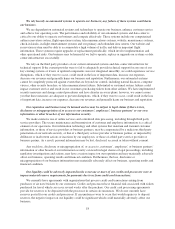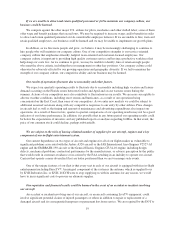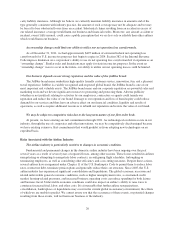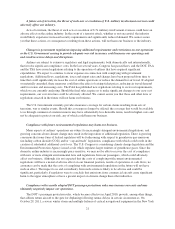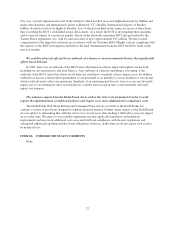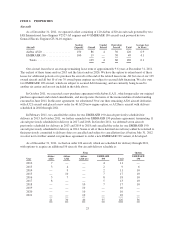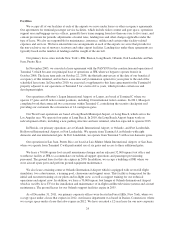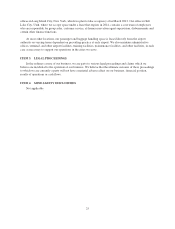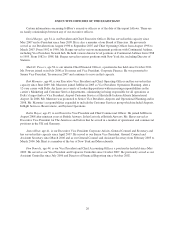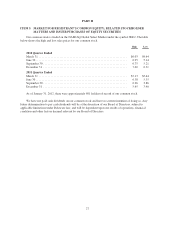JetBlue Airlines 2011 Annual Report Download - page 27
Download and view the complete annual report
Please find page 27 of the 2011 JetBlue Airlines annual report below. You can navigate through the pages in the report by either clicking on the pages listed below, or by using the keyword search tool below to find specific information within the annual report.We may be subject to risks through the commitments and business of LiveTV, our wholly-owned
subsidiary.
LiveTV has agreements to provide in-flight entertainment products and services with six other airlines. At
December 31, 2011, LiveTV services were available on 413 aircraft under these agreements, with firm
commitments for 110 additional aircraft through 2014 and with options for 31 additional installations through
2013. Performance under these agreements requires that LiveTV hire, train and retain qualified employees,
obtain component parts unique to its systems and services from their suppliers and secure facilities necessary to
perform installations and maintenance on those systems. Should LiveTV be unable to satisfy its commitments
under these third party contracts, our business could be harmed.
We may be subject to unionization, work stoppages, slowdowns or increased labor costs; recent changes
to the labor laws may make unionization easier to achieve.
Our business is labor intensive and, unlike most other airlines, we have a non-union workforce. The
unionization of any of our employees could result in demands that may increase our operating expenses and
adversely affect our financial condition and results of operations. Any of the different crafts or classes of our
employees could unionize at any time, which would require us to negotiate in good faith with the employee
group’s certified representative concerning a collective bargaining agreement. In 2010, the National Mediation
Board, or NMB, changed its election procedures to permit a majority of those voting to elect to unionize (from a
majority of those in the craft or class). These rule changes fundamentally alter the manner in which labor groups
have been able to organize in our industry since the inception of the Railway Labor Act. Ultimately, if we and a
newly elected representative were unable to reach agreement on the terms of a collective bargaining agreement
and all of the dispute resolution processes of the Railway Labor Act were exhausted, we could be subject to work
stoppages. In addition, we may be subject to other disruptions by organized labor groups protesting our
non-union status. Any of these events would be disruptive to our operations and could harm our business.
Our aircraft utilization rate to keep our costs low, which makes us especially vulnerable to delays may be
reduced by delays and cancellations in our operating regions which could reduce profitability.
We maintain a high daily aircraft utilization rate (the amount of time that our aircraft spend in the air
carrying passengers). High daily aircraft utilization allows us to generate more revenue from our aircraft and is
achieved in part by reducing turnaround times at airports so we can fly more hours on average in a day. Aircraft
utilization is reduced by delays and cancellations from various factors, many of which are beyond our control,
including adverse weather conditions, security requirements, air traffic congestion and unscheduled maintenance.
The majority of our operations are concentrated in the Northeast and Florida, which are particularly vulnerable to
weather and congestion delays. Reduced aircraft utilization may limit our ability to achieve and maintain
profitability as well as lead to customer dissatisfaction.
Our business is highly dependent on the New York metropolitan market and increases in competition or
congestion or a reduction in demand for air travel in this market, or governmental reduction of our operating
capacity at JFK, would harm our business.
We are highly dependent on the New York metropolitan market where we maintain a large presence with
approximately one-half of our daily flights having JFK, LaGuardia, Newark, Westchester County Airport or
Newburgh’s Stewart International Airport as either their origin or destination. We have experienced an increase
in flight delays and cancellations at JFK due to airport congestion which has adversely affected our operating
performance and results of operations. Our business could be further harmed by an increase in the amount of
direct competition we face in the New York metropolitan market or by continued or increased congestion, delays
or cancellations. Our business would also be harmed by any circumstances causing a reduction in demand for air
transportation in the New York metropolitan area, such as adverse changes in local economic conditions,
negative public perception of New York City, terrorist attacks or significant price increases linked to increases in
airport access costs and fees imposed on passengers.
17


